Contact center software is a business communications solution that enables you to serve your customers across multiple communication channels. Today’s cloud-based contact centers bundle channels like voice calling, SMS texting, live chat, email, video meetings, messaging apps like WhatsApp, and social media. Contact center providers offer these communication services via desktop app, with an agent dashboard.
While a call center focuses on voice only, an omnichannel contact center unifies them in one interface, enabling customers to contact you on the channel of their choosing. Contact center as a service (CCaaS) solutions also include hundreds of digital features including call routing tools, customer self-service capabilities, call monitoring and supervisor support portals, and workforce management features. These advanced features are expected to maintain a 13.6% annual growth rate through 2030.
Let’s take a look at contact center software requirements, with the essential features and capabilities to look for when choosing a call center platform.
Call Center Software Requirements Checklist
Depending on the provider and plan you choose, contact center software platforms can vary considerably in their features, interface, and channel offerings. A call center offers voice only, while a contact center includes other communication channels. There’s also a lot of variety in routing options, customer self-service features, and administrator support tools. Your call center requirements will vary depending on how your company plans to use the software.
When selecting a cloud-based contact center software for your organization, it’s helpful to have a checklist of essential features and capabilities. The checklist below outlines everything you should look for in a contact center, to ensure that you make the best choice for your company.
- Omnichannel communication
- User-friendly dashboard
- Call routing system
- Customer self-service
- Call monitoring
- Workforce management
- Outbound dialers
- Automations and AI
- Interactive voice response
- Analytics and reporting
- Integration capabilities
- Coaching and evaluation
- Security and compliance
Omnichannel Communication Support
In today’s world, customers prioritize convenience–in fact, 87% of millennials say that convenience matters to them significantly. They expect to communicate with companies on the channel of their choosing. To meet this need, choose a contact center provider that offers the communication channels your customers are using: voice, SMS, web chat, video, social media, or email.
An omnichannel platform unifies these channels into one dashboard, so agents can provide customer service on any channel. Integrate these touchpoints into your website, app, and workflow automations, utilizing channels for both inbound customer service and outbound calls. While you don’t need to choose a solution with all these channels, pick one that offers the channels your customers use most often.
Purpose: Improve customer satisfaction and convenience by offering multiple touchpoints for them to connect with your company
Key Components:
- Omnichannel dashboard
- VoIP calling
- SMS texting
- Live webchat
- Video meetings
- Messaging apps like WhatsApp
- Social media
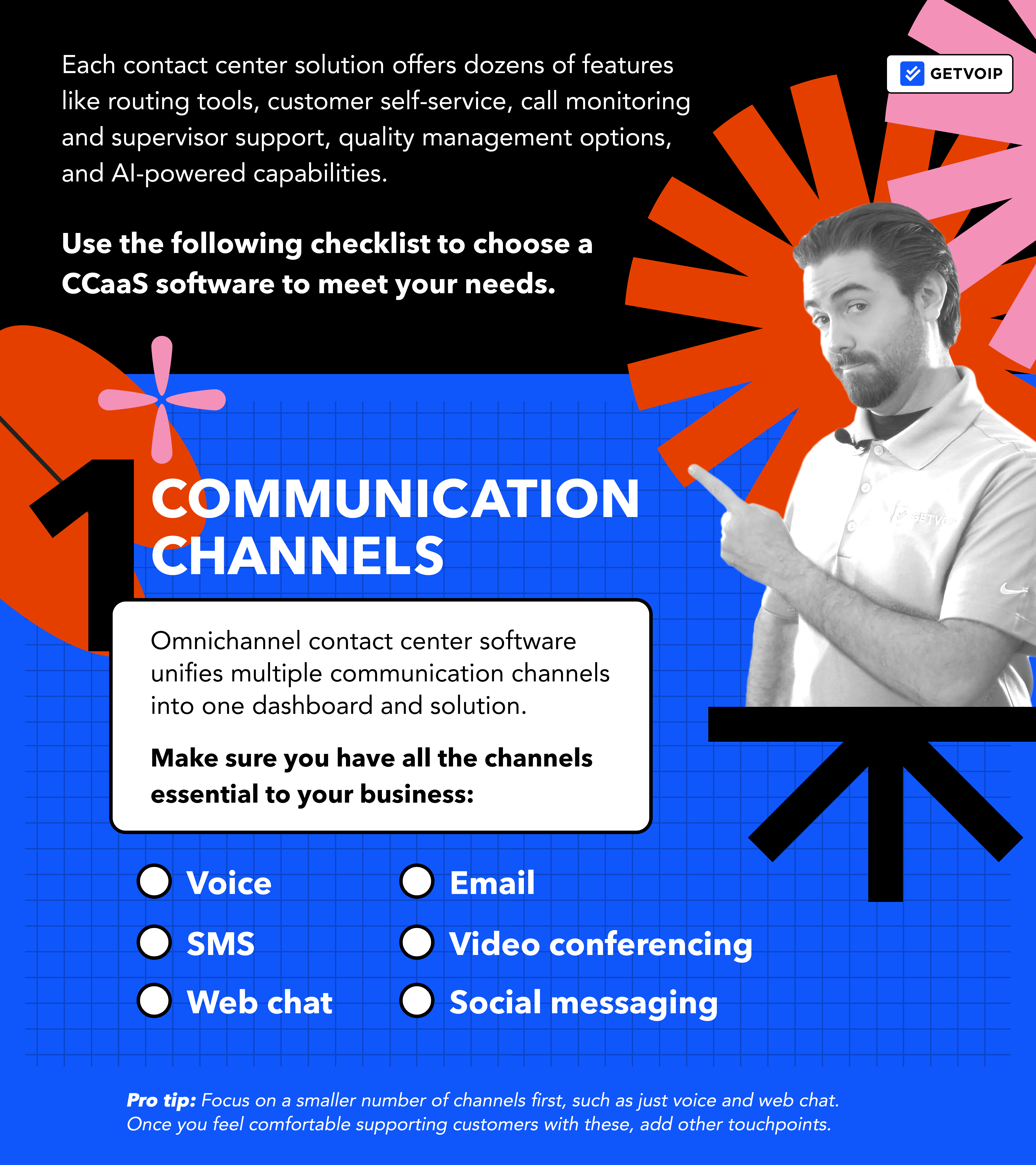
User-Friendly Dashboard
When comparing call center providers, examine each product’s agent interface and omnichannel dashboard. Choose an intuitive and user-friendly interface, with easy access to key features and components.
Purpose: Streamline operations, enhance agent efficiency, improve the overall performance of the call center.
Key Components:
- Call controls
- Communication channels
- Customer information
- Analytics
- Call queues

Call Routing System
A call routing system determines how your phone system handles inbound calls and queries. When a customer contacts your company, the automatic call distribution (ACD) system gathers information about the caller’s identity and the reason for their call. Then, the software routes the query, call, or task to an available agent suited to help.
Today’s call center providers include dozens of tools that automate skills-based routing–not just for calls but inbound queries across all channels. Essential routing tools include interactive voice response (IVR) menus that provide customers with self-service options to choose which department they want to reach. Call queues organize callers into waiting lists when agents are busy.
Purpose: Automatically navigate inbound calls and queries to the best-suited agent
Key Components:
- Interactive voice response (IVR)
- Auto attendant
- Call queueing
- Skills-based routing
- Ring groups
- Automatic call distribution (ACD)
- Caller ID

Customer Self-Service Tools
In addition to IVR menus, contact center self-service tools include chatbots and intelligent virtual agents (IVAs), which can help customers answer questions, accomplish tasks, and reach the correct department.
Call center software provides no-code or low-code editing tools to design chatbot and IVA conversation paths. Customize the menu options, the buttons for customer replies, and identify the touchpoints on your app or website where you want to embed the self-service tools. Live chat and SMS can use natural language understanding (NLU) to power realistic conversations with customers. Self-service bots can handle appointment confirmation, customer information retrieval, order and shipping updates, and more.
Purpose: Help customers accomplish tasks autonomously, saving your agents effort and time
Key components:
- Chatbots
- Intelligent virtual agents (IVA)
- Drag-and-drop designer
- Natural language understanding (NLU)
- CRM integrations
- Knowledge base
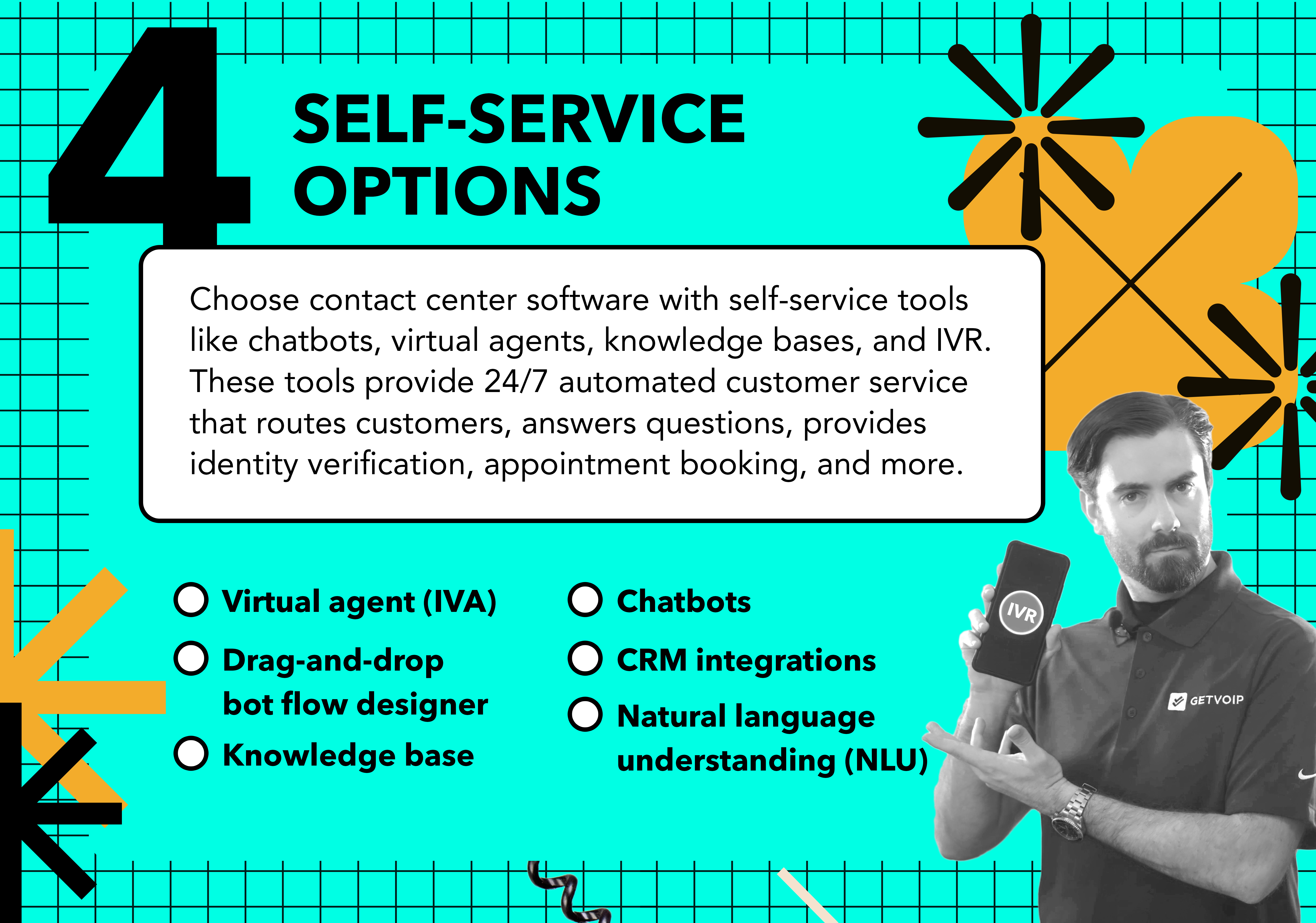
Call Monitoring
Your call center software should include tools that support supervisors and administrators, including monitoring agents and conversations in real-time. A call center app’s supervisor portal, available on desktop, enables call monitoring with listen, whisper, barge, and takeover capabilities.
The supervisor dashboard should enable call center supervisors to have a live view of queue activity, agent status, and all active calls. Most modern systems enable supervisors to join calls from the portal with one click, contributing as a third party or whispering private guidance to the agent when necessary.
Purpose: Assist supervisors in monitoring a large team of call center agents
Key components:
- Supervisor portal
- Call monitoring: listen, whisper, barge, takeover
- Live queue and agent status visibility
- Agent feedback forms
- AI-based interaction flagging
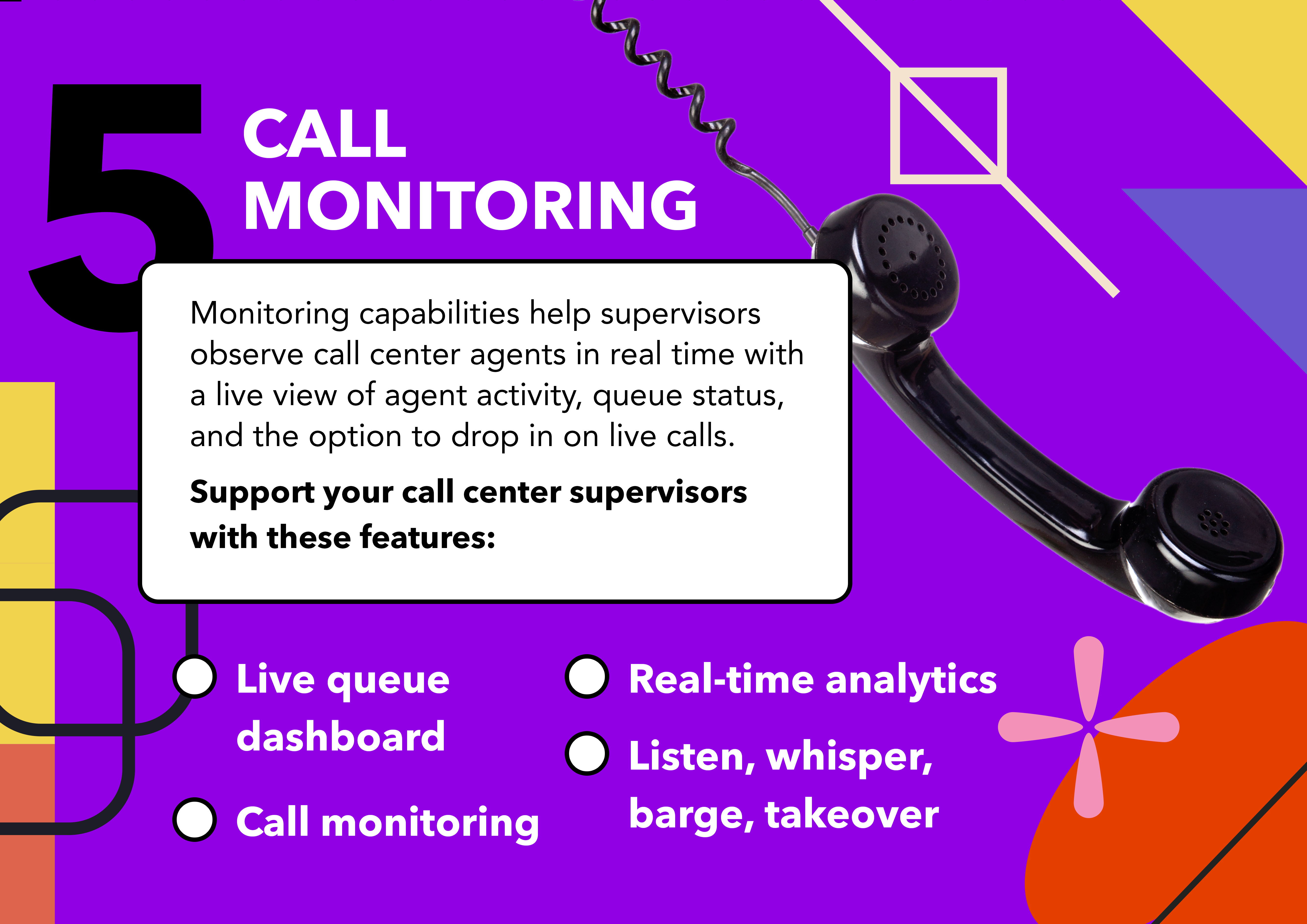
Workforce Management (WFM)
A contact center can support administrators with workforce management tools that automate and improve shift scheduling, staffing forecasting, and employee schedule adherence. CCaaS platforms use AI to anticipate call volume trends, anticipating staffing needs and automatically scheduling call center agents based on their preferences.
Many platforms provide mobile apps for agents, where they can set preferences, view their schedules, and bid for shifts. CCaaS software also tracks employee schedule adherence, monitoring when employees clock in.
Purpose: Predict staffing needs, automate employee scheduling, and provide agents a convenient way to check their scheduled shifts
Key components:
- Call center volume forecasting
- Automated scheduling generation and editing
- Employee adherence tracking
- Agent mobile app
- Agent portal with self-service tools

Outbound Dialers
Sales departments especially benefit from outbound auto dialers. Dialer technology connects to your CRM system or a campaign list, dialing numbers in rapid succession. This saves time for agents, who no longer have to wait for the phone to ring. Voicemail dropping enables agents to leave an automated, pre-recorded voicemail in recipient mailboxes, so agents don’t have to record the same message repeatedly.
Most CCaaS platforms include different types of auto dialers: progressive dialers that call contacts one by one, and preview dialers that provide agents with key customer information before connecting the call. Predictive dialers consider the likelihood of a live recipient answering, balancing this with the number of available agents, to predict when to dial the next contact.
Purpose: Automate lead and campaign dialing for sales and marketing departments
Key components:
- CRM integration
- Progressive dialer
- Preview dialer
- Power dialer
- Predictive dialer
- Voicemail dropping
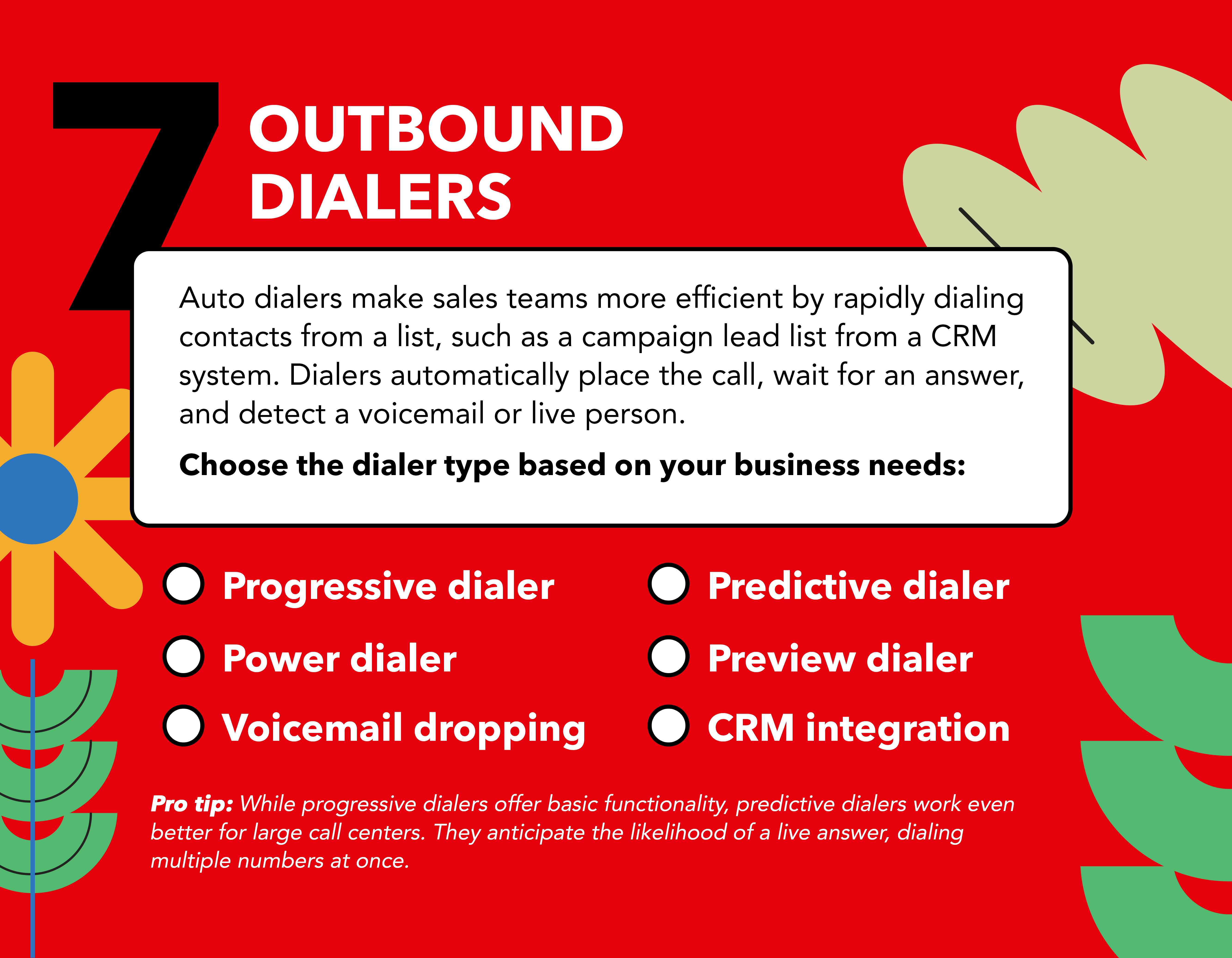
Automations and AI Support Tools
Many of today’s CCaaS platforms integrate AI capabilities that support a variety of functions: live-agent support, conversational intelligence, task routing, and more. Live call transcription provides agents with not only customer sentiment but real-time speech suggestions, relevant knowledge base articles, and related actions. Agent assistance tools can provide instant translations, pop-up answers to customer questions, and automate post-call work.
AI-based conversational tools like virtual agents and IVR systems learn from knowledge base articles and customer trends, leading to more intelligent automations and self-service. With all these advantages, 80% of customer service organizations expect to use AI in some capacity by 2025.
Purpose: Support agents in real-time and help self-service tools work more efficiently
Key components:
- Live agent assistance
- Workflow automations
- Live call transcription
- Automated translation capabilities
- AI-generated insights and call summaries
- Customer sentiment detection
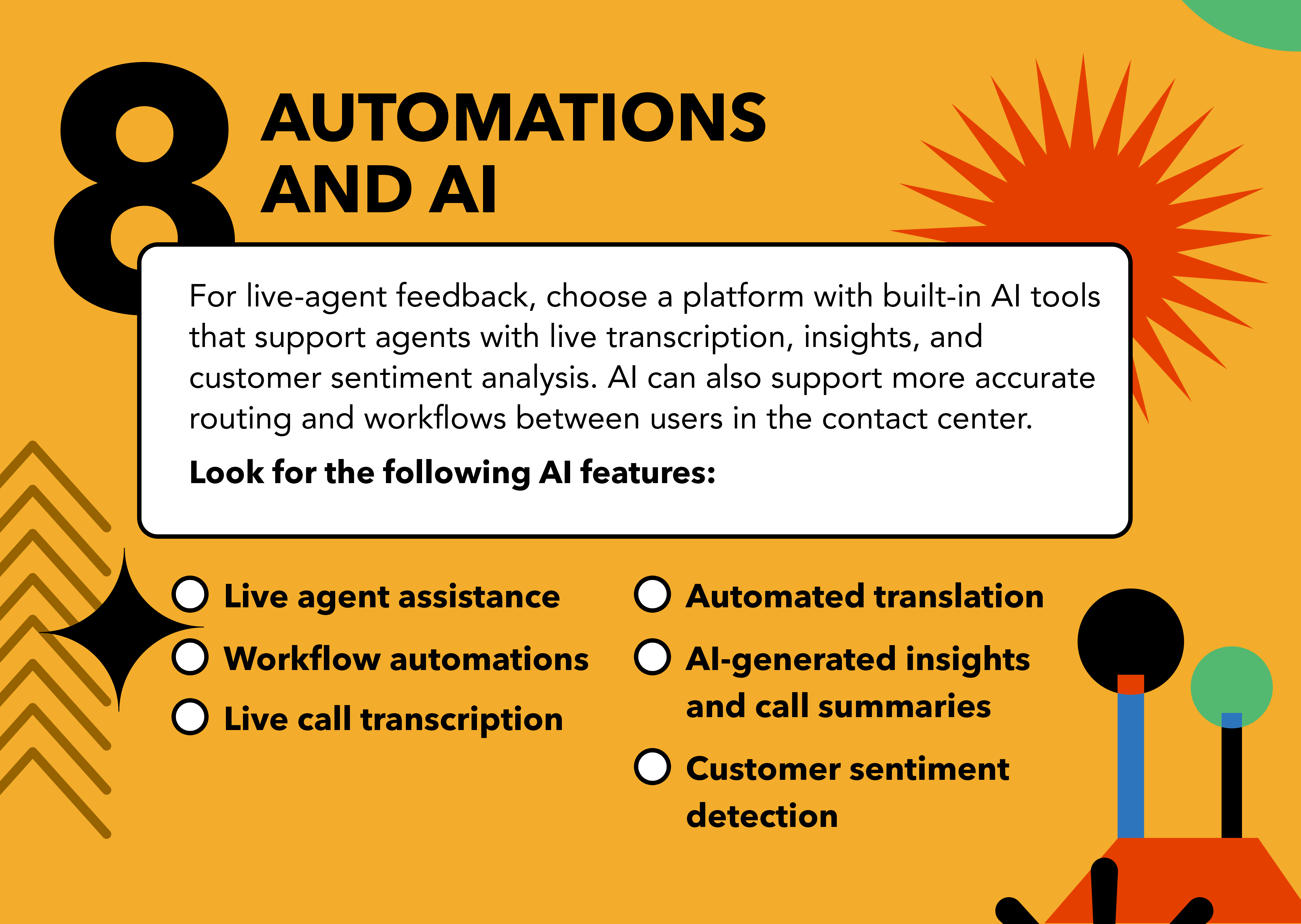
Interactive Voice Response (IVR) System
An IVR menu receives inbound calls and greets callers with a recorded menu, presenting them with options of departments, users, and submenus where they can navigate. IVR menus are a critical part of customer experience, especially since 86% of customers prefer to contact customer support via phone.
Within the administrator portal in your call center software, customize IVR menus and call flows. Assign menu options to phone numbers, users, extensions, call queues, and departments. Many software systems offer a drag-and-drop interface to visualize your IVR call flows, which you can build with no code.
Purpose: Provide customers a self-service menu to reach their intended department
Key components:
- IVR menu
- Auto attendant
- Phone number extensions
- Ring groups
- Call queues
- Drag-and-drop call flow builder
Analytics and Reporting
Call center solutions include analytics and reporting capabilities that track KPIs and trends for hundreds of metrics. In the analytics portal, administrators can view real-time and historical reports with dozens of visual styles–including statistics, charts, tables, and more. Customize these KPIs by user, department, and timeframe.
Analytics monitor call activity, agent performance, queue wait times, and channel usage for all users. In recent years, artificial intelligence features have enabled even more advanced analytics. Modern-day call centers use AI to transcribe calls, identify the customer’s satisfaction and sentiment, and detect conversation topics.
Purpose: Track real-time call activity, agent performance, and customer service trends
Key components:
- Real-time analytics
- Customizable reports
- Call activity metrics
- Multiple visual display styles
- Queue analytics
- Interaction analytics
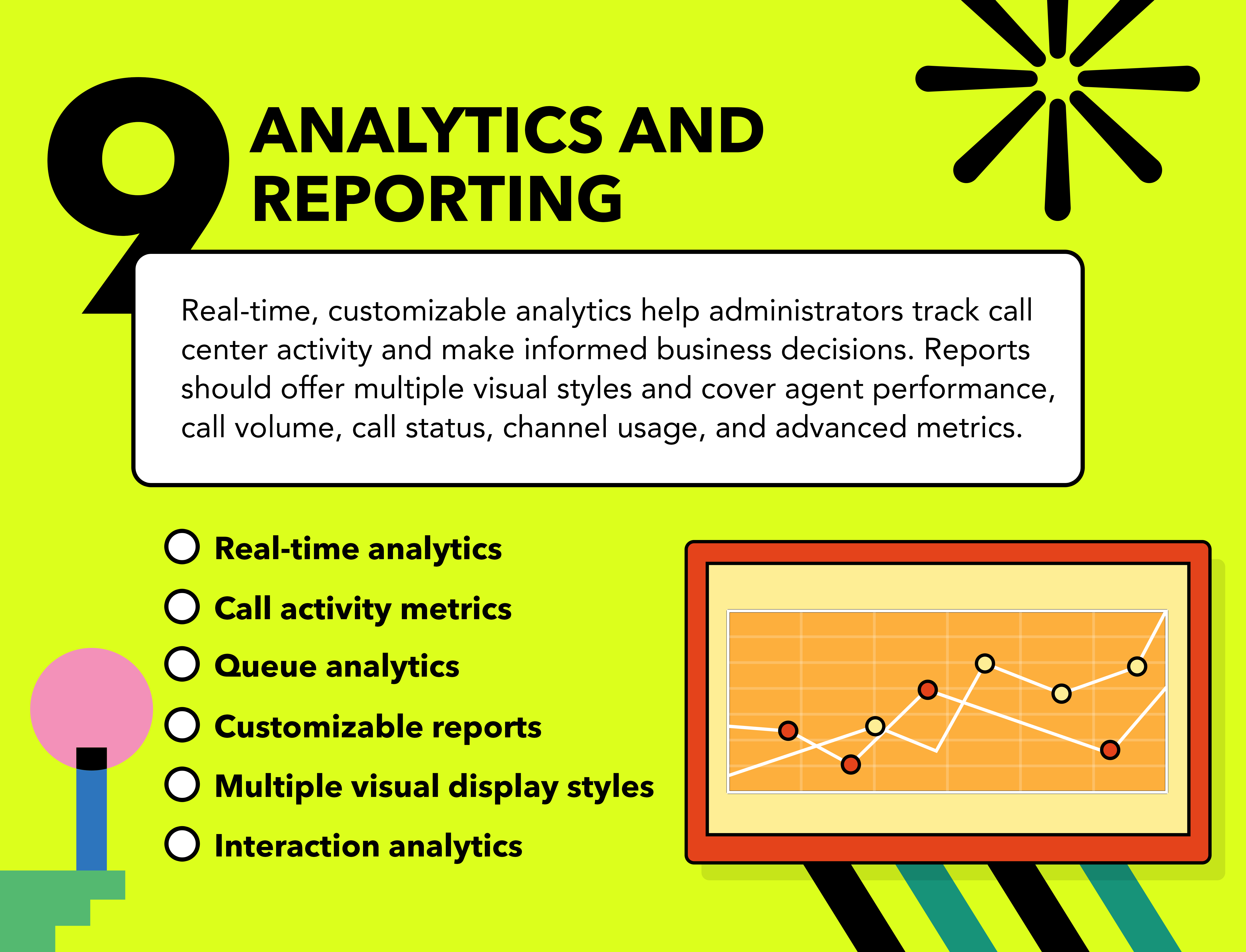
Integration Capabilities
Today’s contact centers integrate with many third-party apps. Integrate data from other tools–like unified communications platforms and CRM systems–into your contact center. By integrating with a CRM system, your CCaaS platform can improve customer service with a stronger customer context, including a customer’s journey history, recent orders, and other information.
Look for a CCaaS platform that also includes APIs and software development kits (SDKs), which enable you to integrate call center operations into a near-limitless number of other apps and systems: databases, websites, application systems, billing, and more.
Purpose: Connect contact center functionality with other applications, like CRM systems and unified communications platforms
Key components:
- APIs and SDKs
- CRM integrations
- Unified communications (UC) integrations
- Ticketing platform and helpdesk integrations
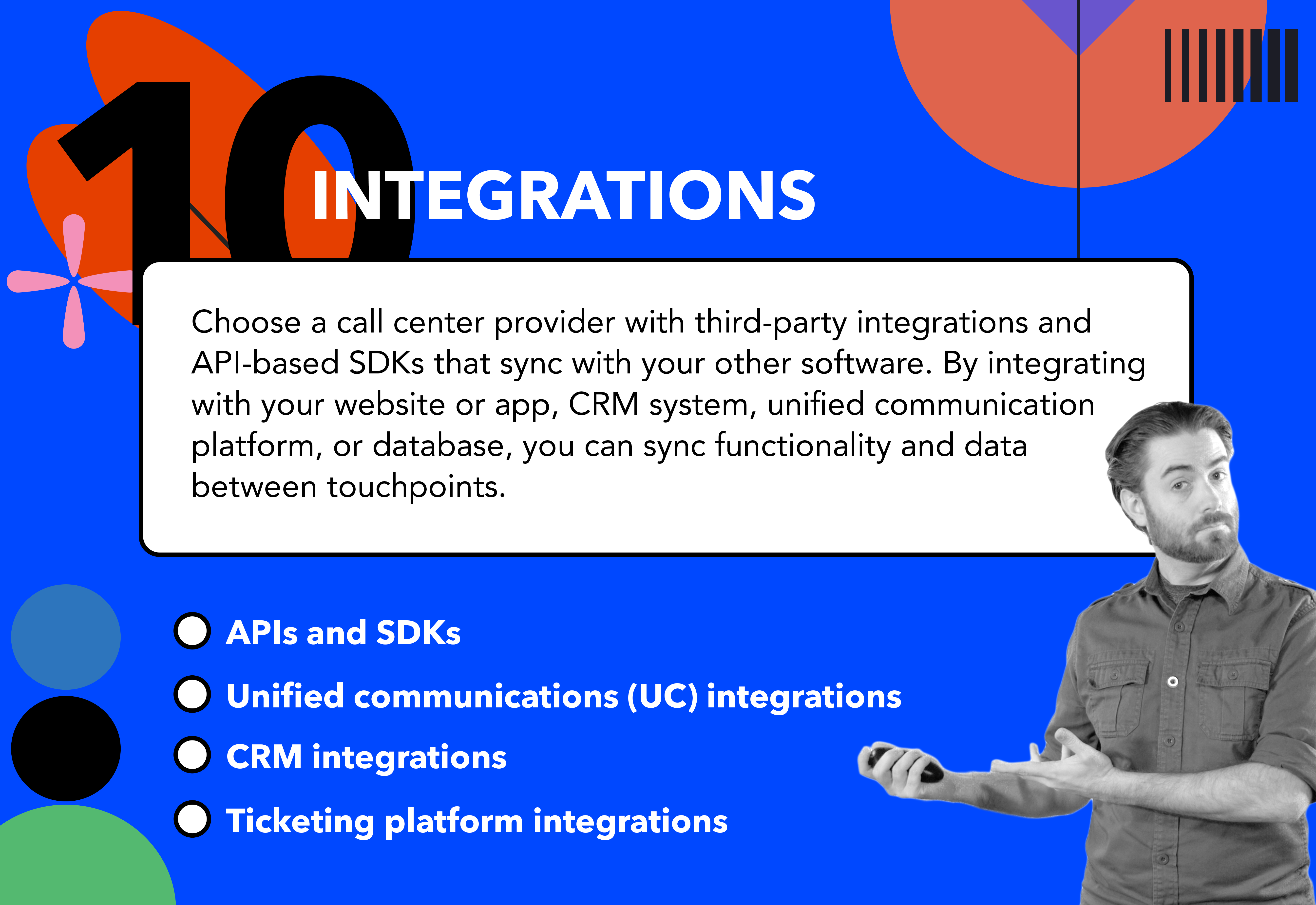
Coaching and Evaluation Tools
Coaching tools make it easier for supervisors to train agents, observe and evaluate performance, and offer feedback. Interaction analytics use transcripts to track sentiment scores, sales conversion ratios, topics, and resolution rates across an agent’s interaction. Alongside call recording, these statistics help supervisors keep tabs on agent productivity.
Call center platforms also include coaching packages, with custom evaluation forms that streamline the feedback process. In advanced systems, AI offers automated suggestions and feedback for agents.
Purpose: Streamline coaching and evaluations for agents
Key components:
- Call recording
- Customizable evaluation forms
- Interaction analytics
- AI-powered agent feedback and coaching
- CRM integration
Security and Compliance
CCaaS software includes features that monitor device connectivity and agent activity, to ensure data security and compliance. Contact center platforms have built-in safeguards that track workstation and device connectivity, notifying administrators and users if a connection becomes weak or compromised, routing phone calls and data to a more secure agent.
Other built-in safeguards track data transmission to ensure that calls, texts, and messaging remain compliant with HIPAA and other international compliance standards. Supervisors can see who’s logged in, along with the quality of each user’s connection, to maintain a bird’s eye view of agent activity and any unexpected behavior.
Purpose: Protect call center and user data, and ensure that your call center remains compliant with standards
Key Components:
- HIPAA compliance
- International messaging standards compliance
- Device connectivity tracking
- Network performance monitoring
- User activity visibility
- Telemarketing sales rules compliance
How to Choose the Right Contact Center Software
When selecting a contact center software, it’s important to consider factors like your budget, business goals, desired features, and customer preferences. It’s also critical to thoroughly compare and evaluate all your options.
Use the checklist below to choose the right contact center software:
- Customer-service goals: Before determining the critical channels and features for your call center, clarify your customer-service goals. List the customer support, technical support, billing, sales and marketing, and other types of business needs for your CCaaS platform, so you can focus on features to meet your needs.
- Budget: Outline a budget for your contact center software. Expect to pay anywhere from $75 to $200 monthly per agent, depending on the channels and call center software features you want.
- Communication channels: Consider all available communication channels–voice, SMS, live chat, email, video conferencing, and social messaging. Many providers offer call centers with phone-only, digital-only contact centers, or omnichannel software with everything. Focus on offering the channels your customers will use the most.
- Routing needs: Consider the reasons your customers contact you, and the channels you offer. Also note how many departments you have and the complexity of your customers’ routing needs when they reach your system. Look for software with drag-and-drop IVR and call queues, plus optional advanced features like queue callbacks and real-time queue dashboards.
- Self-service options: Determine the channels and touchpoints where you plan to offer self-service for customers. Options include not just IVR menus but advanced options like chatbots, virtual agents, and a knowledge base. Look for software with AI-powered chatbots and IVA systems, rich support features like billing, and automated customer surveys.
- Administrator support: Factor the number of agents you have, your center’s remote or in-person status, and what call-monitoring responsibilities your supervisors have. Look for software with call monitoring features like whisper and barge, live queue reports, real-time analytics, and workforce management tools.
- Agent support: Consider how much support your agents need during live calls. For stronger agent support, choose a platform with CRM integrations, quality management tools, live call transcription, and AI-powered support like response suggestions and real-time sentiment analysis.
- Analytics: When evaluating products, look at each option’s analytics portal. Find a platform and plan that offers metrics that will help your supervisors and agents. These may include multichannel usage and activity tracking, call traffic and staffing predictions, and live customer-sentiment scoring. Choose an option with a user-friendly display and customizable report styles.
- Integrations: Make note of the software platforms, systems, and databases that your team uses most frequently. Choose a call center provider with third-party integrations and API-based SDKs that let you connect your CCaaS platform with your other tools. Look for a platform that can connect to your CRM, unified communications, product databases, calendars, billing, registration, and appointment-booking tools.
Determining Your Company’s Call Center Needs
When determining your company’s hosted contact center software requirements, you must first take inventory of your business goals and needs. Compare call center software solutions based on their features, channels, integrations, and pricing. Use the features and items on our checklist above to make sure you’ve fully considered your CCaaS solution requirements.



